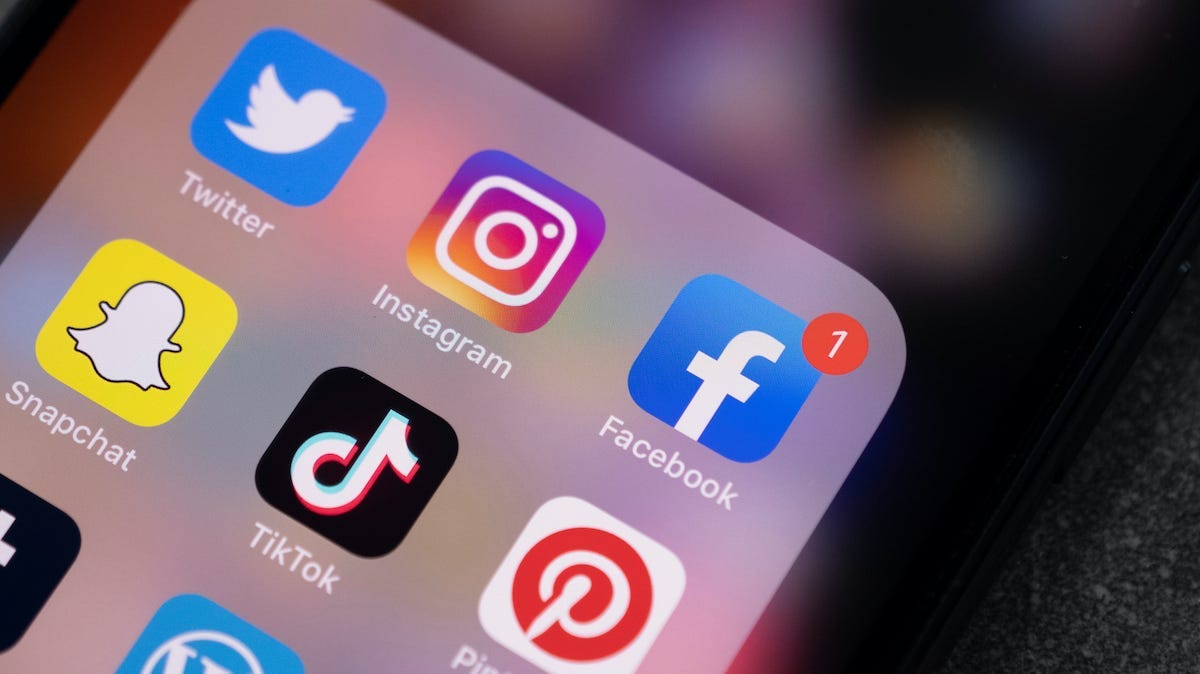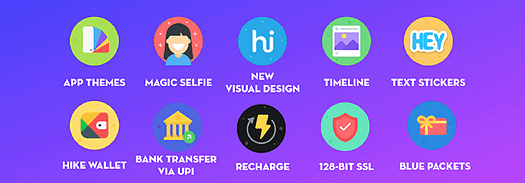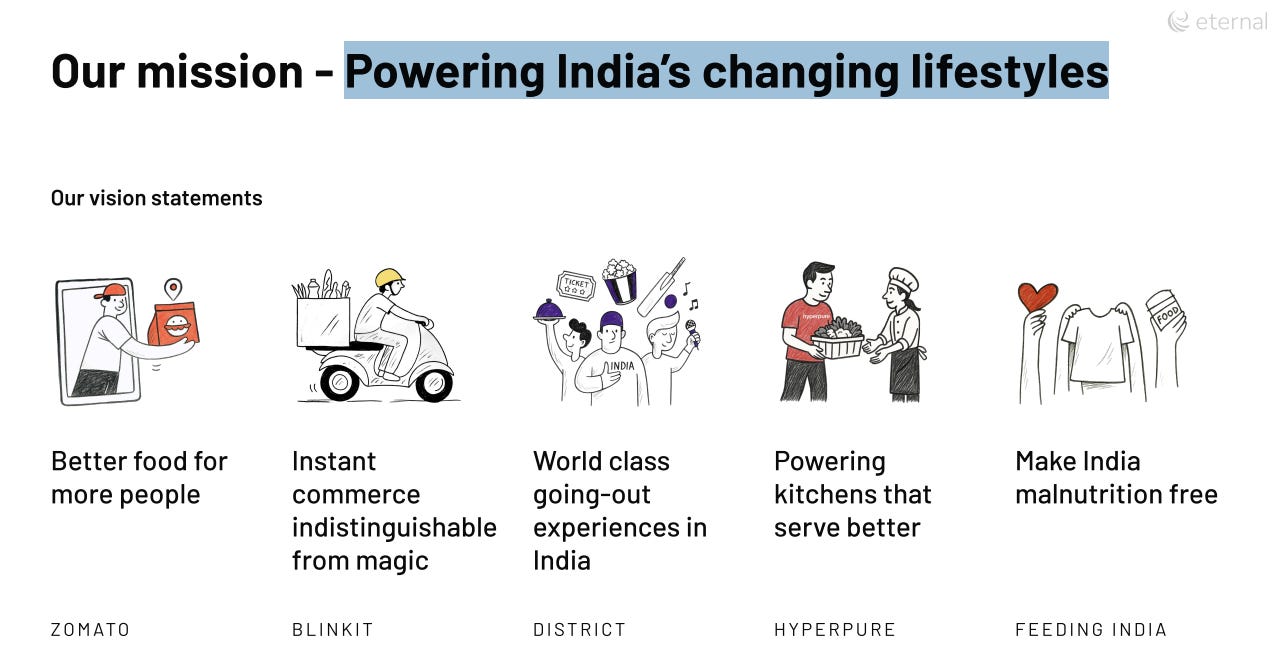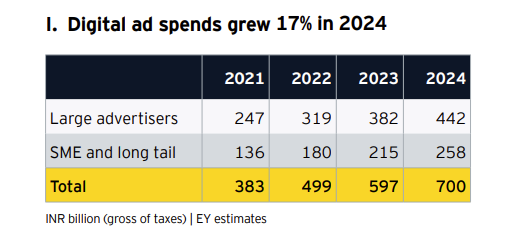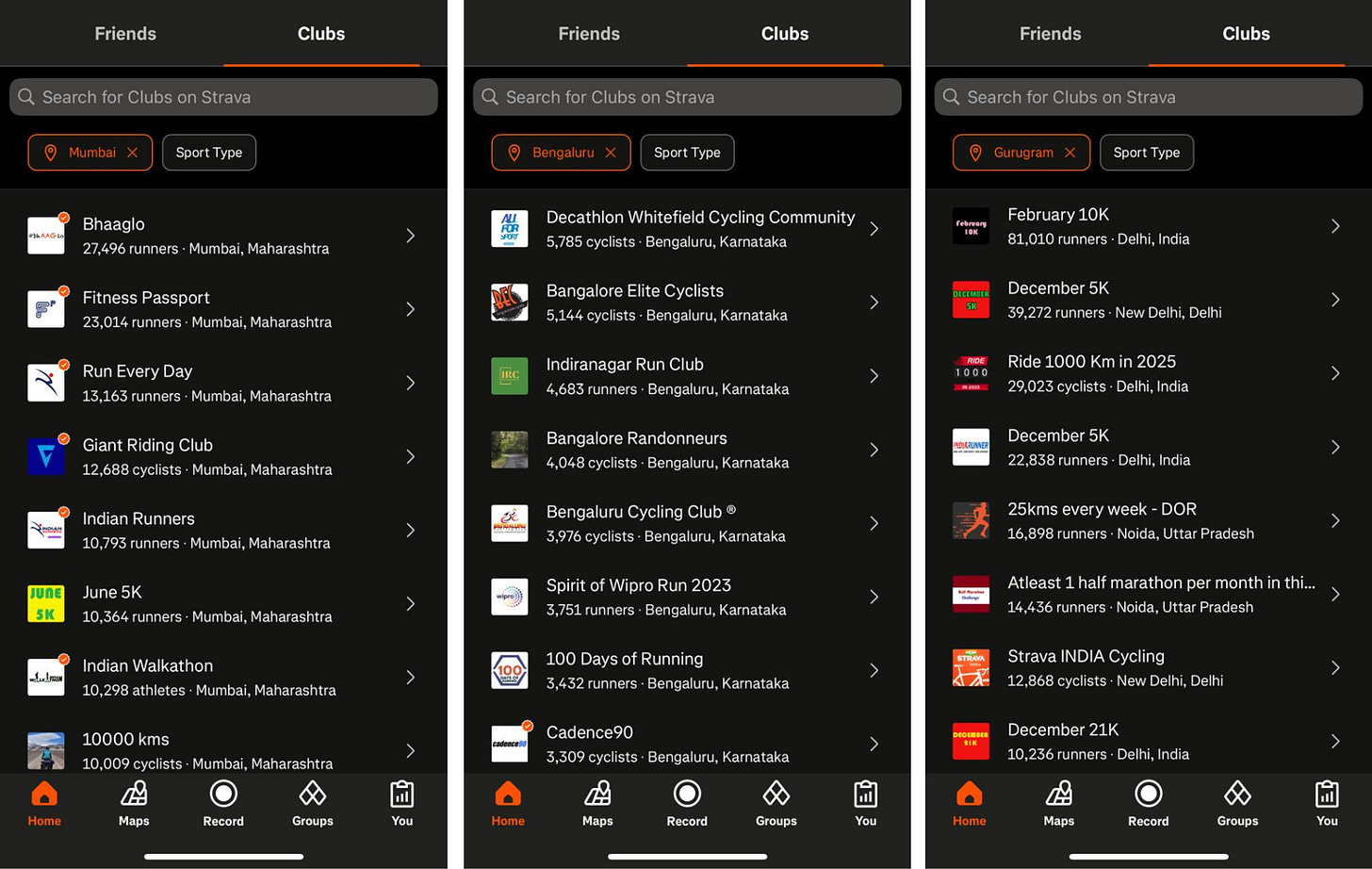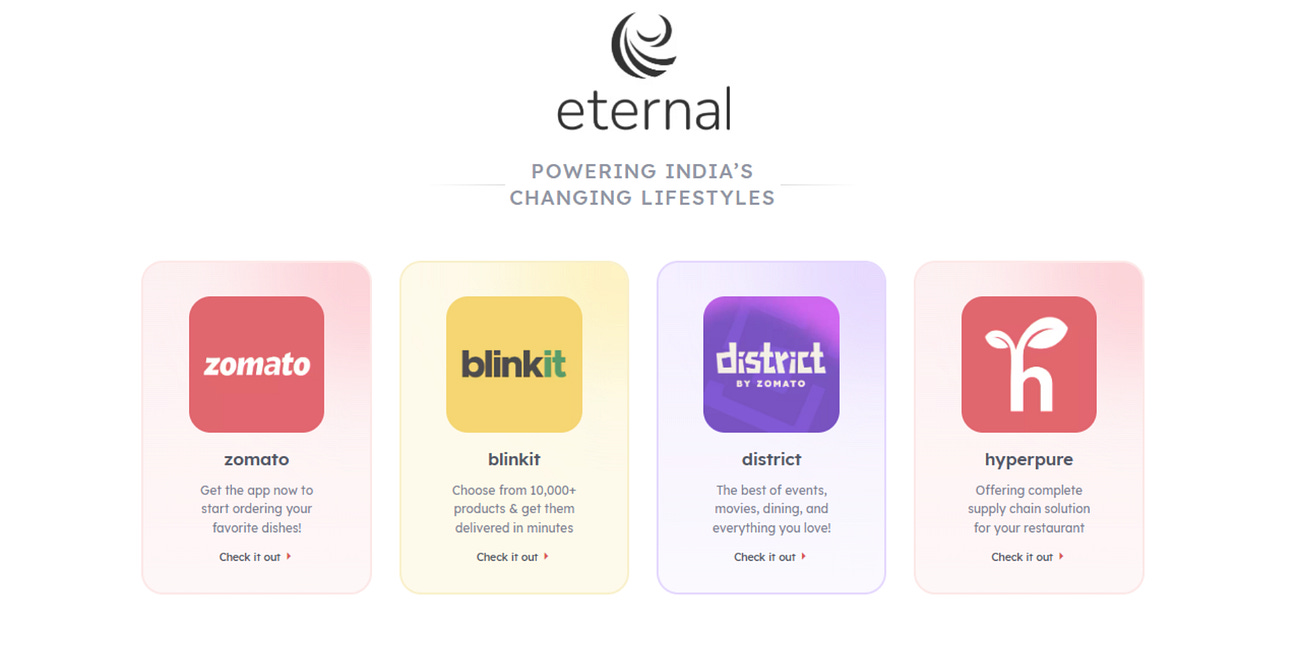Can Eternal create India’s first successful social app?
India must own its digital social future & Eternal can make it happen
For any PE/VC in India, social media is a very dangerous area to invest in. Several startups in India have tried to become the Indian version of WhatsApp, Instagram, X, and whatnot, but none have achieved a scale that could be said to have put a dent in the universe.
The farthest anyone has reached is Sharechat, which after burning over a billion dollar in funding was able to achieve a revenue of Rs 718 Crores in FY 24, and still, not even 1% Indians are using it actively. Compare this revenue with Meta’s Ads revenue from India of ~Rs 23,000 Crores & Google’s Ads revenue from India at Rs 31,000 Crores - Sharechat stands no where.
Therefore, it is not just a drain of India’s precious foreign exchange when we use foreign-owned social media platforms - it is also a drain of India’s personal data. Your data, my data, our national databank on these platforms is accessible by foreign players - this, in itself, can become a major threat to our national security someday.
India must own its social media future.
In today’s blog, I explore how likely it is that Eternal could someday enter this space. While it is a highly competitive and challenging segment to grow in, I believe new opportunities and white spaces are emerging that Eternal could potentially tap into. I am not a social media expert; this blog is written purely from an investor’s perspective.
I would recommend reading this blog on our website here.
Let’s get started.
Why Indian Social Media Apps failed?
There are basically two major Indian social media platforms that have now shut down after achieving some scale, and I am trying to draw some conclusions from their journeys:
Hike Messenger: Launched in December 2012 by Kavin Bharti Mittal, Hike was once one of India’s most promising homegrown messaging apps. At its peak, it boasted over 100 Mn registered users and facilitated more than 40 Bn messages per month. However, its growth happened alongside the giant WhatsApp. I still remember back in 2015-16, reading messages in my school class WhatsApp group discussing why we should use Hike as an Indian messaging app.
Their app distinguished itself by offering unique features tailored specifically for the Indian market, including support for multiple local languages and an extensive range of stickers designed through user-generated contests, which were often not present on WhatsApp back then.
Despite raising over $250 million and reaching unicorn status with a $1.4 billion valuation in 2016, Hike was not able to compete with the deep-pocketed WhatsApp, which kept its interface simple and clean, keeping in mind the 500 million Indians who came online post-2016.
On the other hand, Hike continuously experimented with innovative services like Hike Wallet for mobile payments and attempted to become a super-app by integrating VoIP calling, news, and digital gift envelopes called Blue Packets for peer-to-peer monetary gifts, which made their interface increasingly complex over time.
Basically, despite having that unique edge, Hike Messenger struggled with focus; its original purpose was messaging, but it added games, payments, and feeds, which diluted the core experience. In contrast, WhatsApp focused on its core and kept things simple. (Read more here)
Another factor that may have contributed to Hike’s end was the founder’s persistent disbelief in 2016, expressed as: “For us to win, WhatsApp doesn’t have to lose; the whole perspective changes. Now, data shows us that we sit side by side with WhatsApp”. This mindset contrasted sharply with Facebook’s founder Mark Zuckerberg, who understands that it is often a ‘winner takes all’ game. That is why he consistently pursued acquiring competing apps like Instagram and even WhatsApp itself.

Hike Messenger’s founder on shutting Hike in Jan 2021 Koo, India’s answer to Twitter/X: This app highlighted how strongly multiple segments, including the government, in the country want their own social media platform amid global players. After its launch in 2020, Koo raised $4 million in Series A funding and a further $30 million by May 2021, attracting investors like Tiger Global, Accel, and Kalaari Capital.
The app received strong support from various government entities that actively promoted it. From Union Ministers to Chief Ministers of different states, government bodies such as the Ministry of Electronics and IT, India Post, MyGovIndia, Digital India, and NITI Aayog maintained official accounts on the platform. Many media outlets, including CNBC, also opened accounts on Koo and remained active.
But Koo lacked innovation on the product front. It was seen as a copy of Twitter (now X) and also failed to keep pace with rapidly evolving user expectations regarding features. Content moderation was another major issue on the platform, as reported by many users.
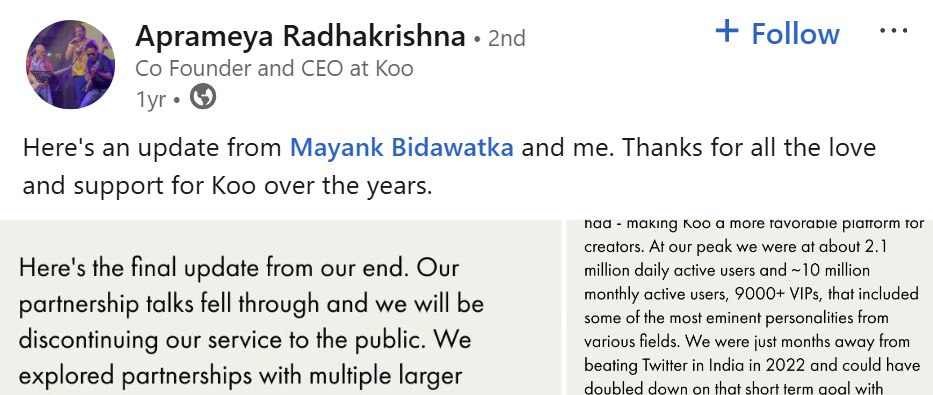
Koo’s CEO & Cofounder on shutting Koo in 2024
Other than ShareChat, Koo, and Hike, we have also seen apps like Moj, a short-video reels format app, experience a sharp increase in usage following the ban of TikTok in 2020. However, this surge was short-lived, and the app has not retain majority of its users, especially after Instagram Reels and YouTube Shorts took over the market.
Therefore, a differentiated and unique offering, deep understanding of core user experience, strong financial backing, and the necessary network effects must be in place to make a social media platform grow successful.
But why Eternal?
As of today (Aug ‘25), Eternal is no where near to becoming a social networking platform and has not announced any such plans - but I feel just the way this company became a core part of our lives today in India, ensuring we don’t become dependent on foreign companies when it comes to food delivery (UberEats which exited India in 2019 post Zomato’s acquisition) and when it comes to ecommerce (Blinkit will soon overtake foreign owned Amazon/ Flipkart), this company can someday also aim to become a core part of our social lives. This would indeed benefit both Zomato and Blinkit. Eternal is also progressing toward market leadership in the 'going out' or experience economy business through District - something which we touch upon later in this blog.
Today, over 2.3 crore Indians order their food through Eternal every month, while about 1.6 crore order their home groceries from their platform. Over the next five years, these numbers are expected to exceed 5 crore each, indicating a much larger audience will come on board in these two verticals alone.
However, when discussing Blinkit's growth and how it currently represents about 70% of Eternal’s total value, we often overlook the ultimate purpose of the company.
Eternal’s core mission is ‘Powering India’s changing lifestyles’. This mission is by no means limited to the food you eat or the groceries you buy today; it is intended to expand far beyond these areas.
The biggest part of our lives is now online on social media. A recent report by EY reveals that Indians now spend an average of five hours daily on their smartphones watching and scrolling across social media (majority time), gaming, and video streaming.
Therefore, if Eternal does not incorporate a social networking aspect, it might not be truly fulfilling its ultimate mission.
This is what makes me think that someday, in some form, the company might strive to build communities and networks, which could trigger a powerful network effect and encourage more people to join their ecosystem.
Before we explore the possibilities of how Eternal could experiment on this side, let’s take a step back and review the company’s interactions with social media, OTT, and content platforms till date.
Back to 2008
When Zomato started as ‘Foodiebay’ in 2008, it was simply a utility platform created for colleagues of Deepinder at Bain & Company’s Gurugram office. They could quickly check food menus for nearby restaurants and then call the restaurant directly to place an order. On that basic HTML website, there were not many network effects or social interactions to encourage a wider audience to join in greater numbers. Users visited the platform for brief periods because it offered a specific utility: providing all the food menus in one convenient place.
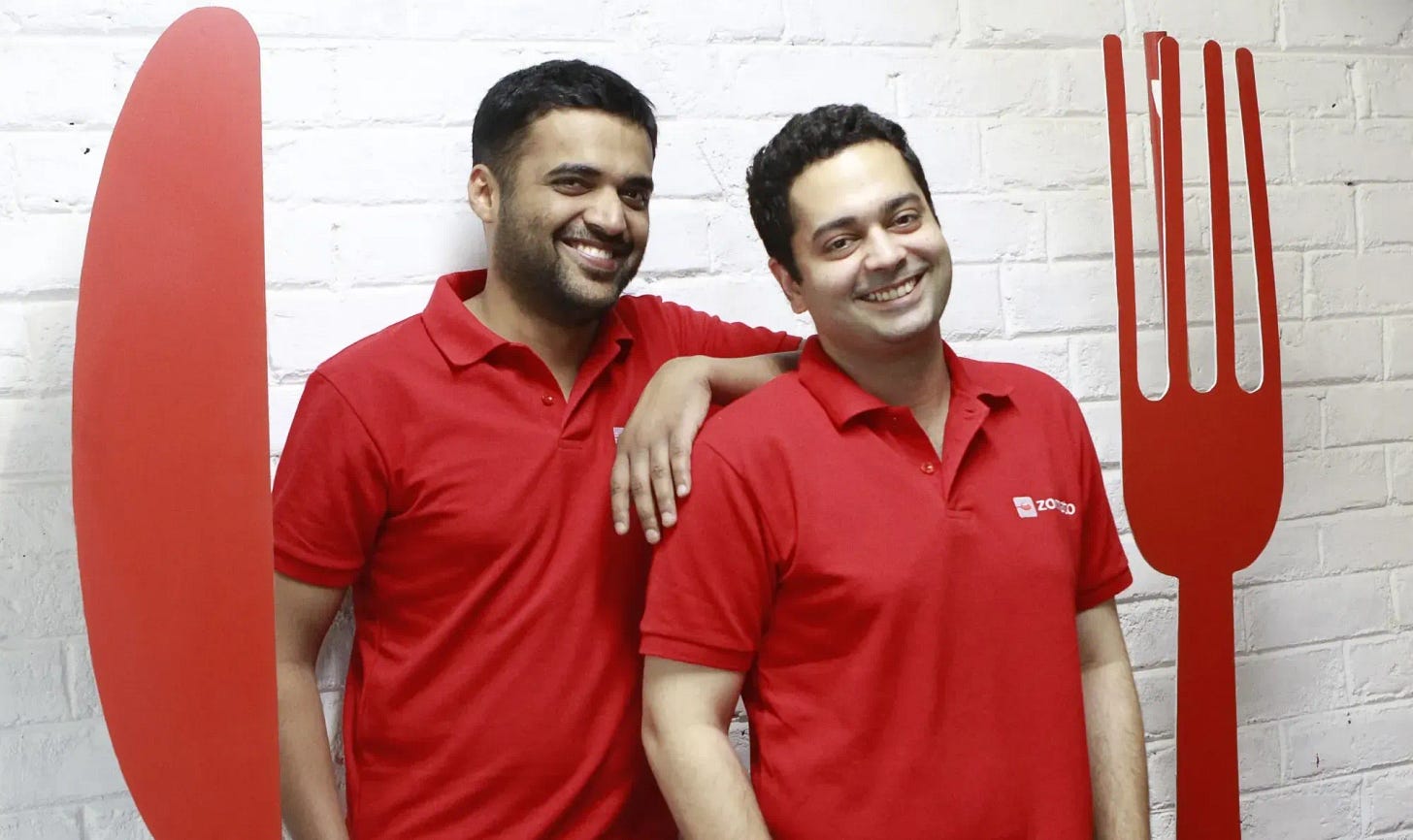
Even today, Zomato primarily serves a specific utility for which customers visit the platform: offering a wide range of restaurant options to order food from, provided by the platform manager. There isn’t much of a social networking element where the value or time spent is created by customers themselves, as is common on a typical social media platform.
Fast forward to 2019
After 10 years of existence, 2019 marked the company’s first formal attempt to enter the content and OTT space (though not social media). Zomato launched a video streaming service to compete with Netflix, Amazon Prime, and Hotstar, releasing 18 original shows over three months starting September 16, 2019. These shows were made available under a new ‘Videos’ tab within the Zomato app.
“Interestingly, most of our users spend a lot of time on our app on a daily basis. This presents the perfect opportunity to discover our video food streams that will make them laugh, learn and come back for more. So, we thought, why not jump right in and redefine a food prime time?”
- Zomato team on launch of ‘Originals’ in 2019 (Source)
While the ‘Originals’ initiative continued for a little over three years after its launch, Zomato decided to deprioritize it around 2021-22. This was likely because the core objective of increasing time spent on the app did not see the expected improvement.
Post Covid
Digital ad spending is now the largest component of marketing for majority companies, as well as for emerging D2C brands. In total, around ₹70,000 crore was spent on digital ads in 2024, nearly double the amount spent in 2021. About 70% of this spending takes place on social media platforms and search, while advertising on ecommerce platforms accounts for ~21% of the total.
Seeing the growing importance of social media advertising, Eternal launched SocialAds, a product that integrates high-reach ad platforms like Meta and Google with a conversion funnel designed to encourage repeat buying behavior on consumption platforms. Essentially, SocialAds enables advertising on social media, engages users with interactive ads, and directs traffic to apps like Zomato & Blinkit to drive consumer purchases.
I wrote a detailed version on this in blog below along my fellow co-authors few months ago: Why Zomato needs an AWS moment?
The close interactions between consumer on-app data and off-app social media data will provide immense learning opportunities for the company whenever it decides to build its own social platform.
Has rise of Experience Economy opened a white space?
The reason I decided to write today’s blog is that I see a significant an opportunity emerging for a social platform dedicated to capture the rise of the ‘Experience Economy’ in our country.
“The period between early 2024 and mid-2025 marked a profound evolution in India’s live entertainment industry - not merely in scale and volume, but in the very structure, expectations, and cultural impact of live events.”
- MIB, Government of India (Whitepaper)
From the over 222,000 attendees in Ahmedabad alone at Coldplay’s concert, where only about 20% of the audience was actually from Gujarat, and rest of them traveled to the state to attend. India has never travelled at such scale to another state for any event expect in case of the world cup. Performances by Ed Sheeran, Dua Lipa, and Bryan Adams, we have started to see many international artists coming to India to perform for the first time.
‘Experience’ is a very broad term, with ‘Events’ being just one niche category. Other similar categories include ‘Dining’, ‘Movies’, ‘Sports events’, ‘Comedy shows’, and many more are getting ready to emerge. Eternal’s District aims to go deep into all these areas.
As of today, most social content related to these categories is found on YouTube (long-form videos) and Instagram (short-form reels), which serve as directories for such content. The true value these platforms provide lies in their robust analytics & recommendation systems, which understand user preferences and keep users engaged for extended periods with the types of content and themes they relate to the most.
Each of these niche categories has the potential to bring together a unique group of users who share and engage with content related to that specific type of experience.
Learnings from Strava
Strava is an American fitness tracking app founded in 2009 that combines GPS-based activity tracking with social networking features. At core, Strava records detailed data from workouts, including distance, time, speed, elevation, and route maps, for activities like running, cycling, swimming, hiking, and over 40 other sports.
"If it's not on Strava, it didn't happen"
Unlike broader social platforms, Strava built deep engagement by serving a specific community's needs: serious athletes who wanted data-driven insights combined with motivational social interaction. The app grew from a ‘niche cycling platform’ in 2009 to over 150 million users globally in 2025, generating ~$400 million in revenue. Recently the company was valued at $2.2 Bn in their latest funding round.
Users on its platform can follow friends, give "kudos" to activities, join clubs, participate in challenges, and compete on "segments" (specific route sections where you can compare times with other users). The platform gamifies fitness through leaderboards, personal records, and achievements, creating what the founders call a ‘virtual locker room’ for athletes.
The app has found its own unique audience that regularly shares their Strava activity status with peers on other social media platforms. And now it is becoming the next big thing in India. Their user base is growing so fast. In a recent interview, their CEO mentioned that ‘South East Asia’ has become the biggest growth driver for the company.
In recent years, ‘Running’ has gained significant popularity as a fitness activity in India, with hundreds of running clubs and groups emerging across the country. The 20th edition of the Mumbai Marathon saw over 60,000 athletes participating!
Running is now one of India’s fastest-growing sports despite the infrastructure challenges that exists - Bloomberg (2025)
Strava has emerged as a direct beneficiary of this trend by specifically targeting serious athletes and fitness enthusiasts rather than casual users. Therefore targeting a niche segment to begin with is not a bad idea.
Bottomline
Majority of what you read in today’s blog is based on my own imagination and might never happen in future. I have simply tried to connect the dots to explain why I think the possibility is real & why it makes sense for Eternal to consider this direction.
Social apps have grown very quickly in recent years, especially after Covid, but India’s social media penetration is still well below global averages and behind countries like Brazil. As income and aspirations rise, and with the availability of low-cost internet and smartphones, there is still significant room for growth in social app usage.
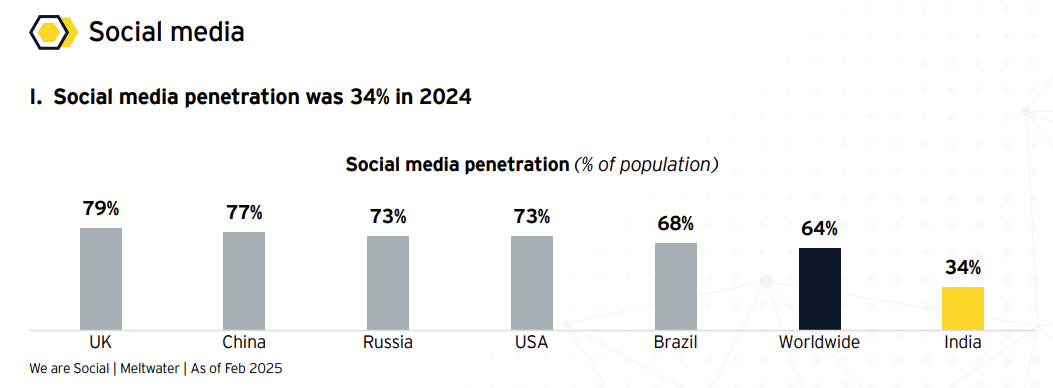
Eternal’s apps are known for their excellent UI/UX and overall user experience, making them some of the most transacted platforms in the country. With the ‘Experience Economy’ just beginning to grow and District positioned at its center, a significant whitespace could open up for a social networking platform where people connect with like-minded individuals.
I truly hope that someday we have India’s own social platforms where we choose to spend our time, and I believe Eternal has the potential to make that happen.
Thank you for reading today’s blog, share your view/feedback in comment below.
Connect with me on LinkedIn here.
Finding Outperformers will always remain a free-to-access website. If you find our work valuable, consider supporting us contributing to our research here:
Read my recent publication on Eternal:
Disclaimers-
We are not a SEBI registered advisors; personal investment/interest in shares can exist for any company mentioned above; this isn’t investment advice but our personal thought process; DYOR (do your own research) is recommended; Investing & trading are subject to market risk; the decision maker is responsible for any outcome.


